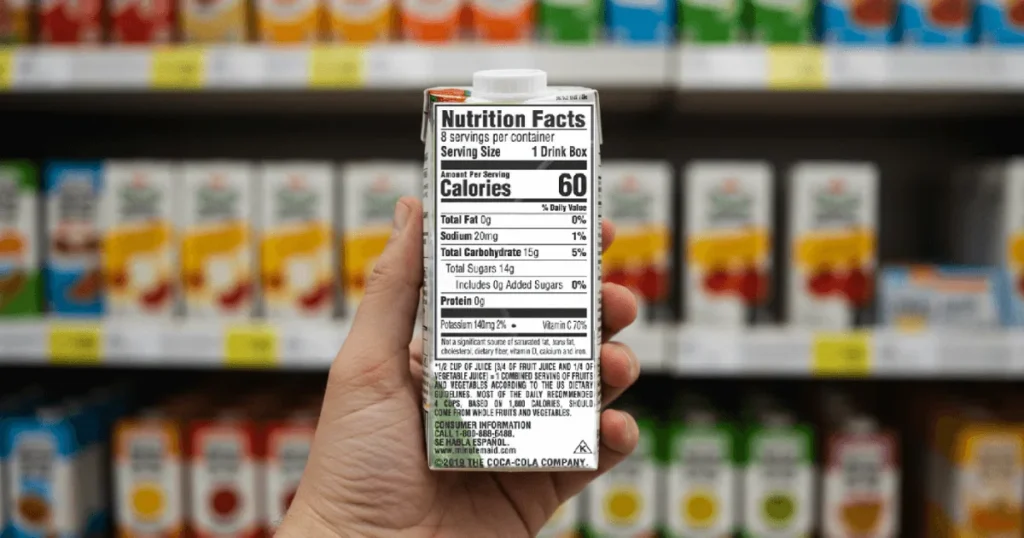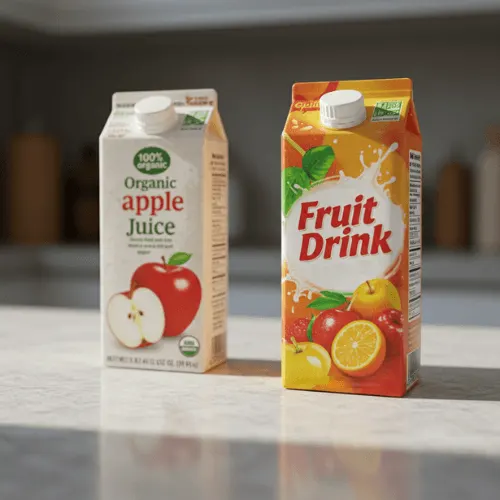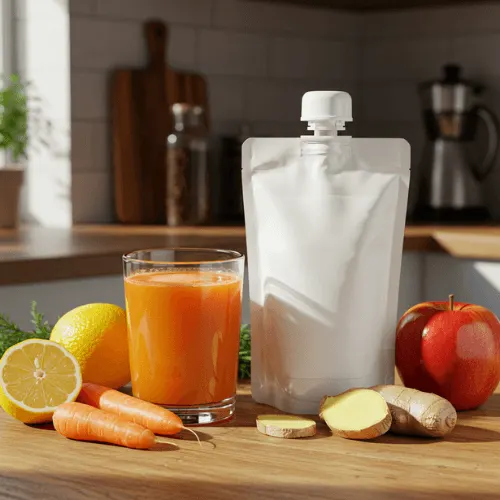The juice box aisle is a battlefield. Your kid is chanting for the one with the cartoon character while you’re squinting at labels, thinking, “Since when did ‘fruit punch’ require 12 ingredients?” We’ve all been there.
Here’s the truth: That “100% juice” claim? It’s still sugar in a tiny box. And those “no added sugar” boxes are often packed with sneaky concentrates. My kid once turned into a tiny tornado after a “healthy” juice drink—never again.
Table of Contents
Grab the 4-oz boxes (an actual serving size) or dilute juice with water. Better yet, skip the drama and pack water (though good luck with that).
In the end, achieving balance is key to parenting. Some days you’ll pick the organic unicorn juice; other days you’ll cave to the neon-blue “blast berry” because it’s been one of those days. No shame. We’re all just surviving the sugar rush together.
Where’s my kid’s juice?
Juice Labels: The Sneaky Truth Nobody Tells You
I used to be the parent tossing juice boxes in the cart without a second glance. “It’s got fruit on the label; how bad could it be?” Famous last words. Juice companies are strategizing on a chessboard while we’re stuck with checkers.
The Good Guys (Yes, They Do Exist)
The surprise of stumbling upon $20 in a jacket you hadn’t thought about. That’s what spotting “100% juice – no added sugar” feels like. These unicorns give your kids:
- Real fruit sugar (not the lab-grown stuff)
- Vitamin C – nature’s immune system bodyguard
- Sometimes, bonus calcium (for kids who think milk is poison)
Pro tip: If the ingredients list is shorter than a toddler’s attention span, you’re golden.
The Juice Imposters (AKA Sugar Bombs)
Here’s where it gets shady. Watch out for:
- “Juice drink” or “cocktail” – fancy words for products with only about 5% juice
- High-fructose corn syrup – because regular sugar wasn’t sweet enough?
- Red 40/Yellow 6 – if it looks like it could glow in the dark, put it back
One of the most misleading tricks? The front screams “MADE WITH REAL FRUIT!” but the fine print says “contains 10% juice.” That’s like putting one blueberry in a muffin and calling it health food.
How to Read the Label (Without Needing a PhD)
- Flip the box over: The pretty pictures lie, the nutrition facts do not.
- Check serving size: That “small” juice box might be over two servings—sneaky!
- Sugar math: More than 10g per serving? Probably not worth it.
Fun fact: Dentists hate juice more than kids hate vegetables. That should tell you something.
The Cold Hard Truth
Even the “good” juices are still fruit smoothies without the fiber. My rule? If I didn’t let them eat five oranges in one sitting, maybe they don’t need eight ounces of OJ either.
Water’s still the MVP. But for those days when only juice will do (we’ve all been there), at least now you know how to pick the least terrible option.

The Juice Box Dilemma: Convenience vs. Sustainability
I admit it—I never thought much about juice boxes until I looked into how they’re made. Honestly, these tiny cartons are engineering marvels.
How Do They Work?
Your average juice box is a six-layer fortress protecting your drink:
- Paper for structure
- Plastic to prevent leaks
- Line the interior with aluminum foil to protect from light and oxygen.
The wildest part? They’re sterile—meaning they can stay in your pantry for months without spoiling (or needing preservatives). It’s the same technology used in some medical supplies.
The Trade-Off: Easy to Use, Hard to Recycle
Let’s be real: Juice boxes are ridiculously convenient. No fridge needed, kid-proof design, and let’s not forget the magic of bendy straws. For busy parents, their extended shelf life is a real lifesaver.
But here’s the catch: Recycling them is a nightmare. Those same protective layers mean most facilities toss them straight into landfills. So, while they’re practical, they’re a tough sell for eco-conscious families.
The Good Stuff:
- Super portable and kid-friendly
- No refrigeration needed
- Stays fresh for a long time
- Bendy straws = instant joy
The Not-So-Good:
- Recycling? Nearly impossible
- Single-use waste adds up
- Often pricier than bigger bottles
Do the pros outweigh the cons for your family? Only you can decide.
Juice Box Smarts: How to Pick the Good Stuff
The juice aisle is overwhelming. Instead of listing specific brands (since every store’s selection differs), here’s how to spot winners:
How to Find the Good Guys
The best brands don’t play hide-and-seek with ingredients. Look for:
- Labels that clearly say “100% juice” and list what’s inside
- No vague “natural flavors”
Bonus points for:
- USDA Organic
- Non-GMO Project Verified seals
These aren’t just fancy stickers—they mean the juice went through actual testing (unlike the “all-natural” claim slapped on everything).
What Makes a Juice Box Worth It?
- Short, simple ingredients—like “apple juice, water, vitamin C.” If it reads like a lab experiment, pass.
- Real nutrition—some juices pack a full day’s vitamin C or even vitamins A & E.
- No sneaky sugar bombs—avoid “juice cocktails” or anything with added sweeteners. ‘Organic cane syrup’ is, in fact, still sugar.
DIY Juice Boxes (For the Overachievers)
Want total control? Make your own! It’s cheaper, fresher, and kids enjoy helping (or at least pretending to).
Kid-Approved Carrot Juice Recipe
Sweet, sneaky, and tasty:
- 1 lb carrots (organic if possible)
- 1 apple (the secret weapon—makes it drinkable)
- A small amount of ginger, comparable to the size of a pinky nail
- Squeeze of lemon (keeps it bright)
- Water (to thin it out)
Blend, optionally strain, and serve over ice. Store leftovers for up to two days. Use reusable pouches for a DIY “juice box” effect.


Juice Box FAQs
What even is a juice box?
A tiny, unbreakable thermos for kids. Made from layers of paper, plastic, and aluminum foil, these shelf-stable sippers blew up in the ’80s because—let’s be honest—no one wants to lug glass bottles to soccer practice.
Are they that bad for recycling?
Sadly, yes. Those genius layers that keep juice fresh are a recycling plant’s nightmare. Some facilities can process them (check your local rules!), but most end up trashed. Eco-win: Look for Tetra Paks with the recycling symbol—they’re slightly better.
How do they last so long without refrigeration?
Aseptic processing—the same sterilization tech used in hospitals. The juice and box are sterilized, so no fridge (or preservatives) needed.
How much juice is too much for my kid?
Doctors recommend 4–6 oz max per day (about one small box). 100% juice has the same sugar content as soda. Dilute with water, or mix with sparkling water for a “fancy juice” kids will love.
Is organic worth the extra money?
If you buy organic apples, yes. It’s not about nutrition—it’s about dodging synthetic pesticides. (If your budget’s tight, thoroughly wash non-organic fruit before juicing.)
Can juice boxes be healthy?
In moderation, yes! Choose ones with:
- No added sugar (100% juice only)
- Bonus nutrients (like vitamin C or A)
- Short ingredient lists (e.g., “Water, apple juice, lemon juice”)
The Bottom Line
Choosing juice boxes shouldn’t feel like solving a math problem. Sure, it’s good to pay attention (100% fruit juice, no sneaky sugars, all that), but don’t lose sleep over it. Find something your kids will drink—and that you feel okay about.
Every family’s different. Maybe you’re all about organic. Maybe you just grab whatever’s on sale. Or maybe you’re the parent secretly judging others at the soccer game for their juice box choices (no shame—we’ve all been there). The key takeaway is that there is no definitive ‘right’ answer.
The good news? There are way better options now than when we were kids. Companies are starting to figure out parents want less sugar and more real ingredients, without making juice boxes taste like watery celery.
Here’s an idea: Next time you’re packing lunches, peek at the juice box label—not to stress, just for curiosity. Or better yet, let your kids mash up some fruit and call it “homemade juice” (bonus points if they drink it). Either way, you’re doing great. You’re reading this—that means you care, and that’s already a win.

